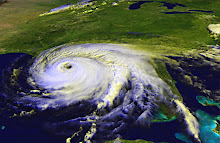| Storm | Formed | Strength | Landfall |
| T.S. Alberto | August 5, 1988 | tropical storm | Canada |
| Hurricane Arlene | August 8, 1987 | Cat 1 | Carolinas |
| T.S. Arthur | August 28, 1984 | tropical storm | none |
| Hurricane Alicia | August 15, 1983 | Cat 3 | Texas |
This morning, the National Hurricane Center is watching a tropical wave off the coast of Africa. Conditions are fairly good that this will develop. Early computer models available on Crown Weather and Weather Underground (see my links to the right) suggest that the system will move west northwest. Maybe it won't turn into a named storm. Maybe it will stay out in the Atlantic. If it does make landfall, it could strike anywhere along the eastern seaboard from Florida to Canada. If it makes a southerly turn, it could threaten Caribbean islands or any location around the Gulf of Mexico.
Yes, that's a lot of ifs, but if you have made no preparations for a hurricane and you live anywhere along the Atlantic or Gulf Coasts in North America, now is your chance to make a few moves.
- Buy a few extra gallons of water and some food that doesn't require refrigeration.
- Make sure you have a battery-operated radio and flashlights AND fresh batteries.
- Check your medicine cabinet or first aid kit to make sure you have Band-Aids, antibacterial wipes, rubbing alcohol, aspirin or acetaminophen.
- Think about how you'll prepare your home and family if the storm comes your way.
Some people do nothing before a storm and rely on the government or other agencies to help them if they need it. Some people wait until the last minute, then run willy-nilly through the grocery store, throwing $200 worth of water, juices boxes, crackers, bread, and canned goods into their carts.
Think calmly and rationally now, when you're not under an immediate threat. One gallon of water per person per day is a good plan, because it'll be hot and you may be exerting yourself physically to clean up damage.
If you have a lot of food in your freezer, do you have a way of keeping it cool (generator) or of cooking it (gas stove, grill)? If so, you may not need to worry about having three days worth of canned goods.
Look at what you have in your pantry. Can you make breakfast, lunch, dinner, and a couple of daily snacks for your family for three days without electricity? If so, you won't have to spend a lot of money on food.
Think ahead now to special needs -- do you rely on prescription medication, oxygen, or home health aides? If so, talk to your providers and understand what will happen if electricity is out or roads are impassable. Is there a special needs shelter? Should you go there? Can you get on a list of "first response" at your power company? These are questions to ask now, not when you have a storm bearing down, offices are closing, phone lines are jammed.
Don't wait until the storm is at your doorstep to make plans.

No comments:
Post a Comment